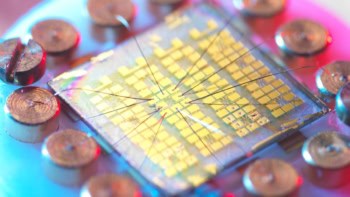Physicists in Japan have made a device that can detect individual electrons that are flowing either forwards or backwards. The device -- the most sensitive ammeter to date -- allows currents to be measured in the attoampere range for the first time. Dubbed a bi-directional single-electron ammeter, the device could be used for a wide variety of applications, including nanoelectronics, calibration devices, quantum computation and biology (Science 312 1634).

When it comes to detecting individual electrons, it is important to be able to measure electrons travelling in both the forward and backward directions because many electrons get “backscattered” in a device. Although scientists have recently been able to count single electrons travelling through an individual quantum dot — a nanostructure that confines electrons in 3D — these experiments have been unable to work out which direction the electrons are travelling in. By including two quantum dots, rather than one, the new device gets round this problem.
Built by Toshimasa Fujisawa of the NTT Basic Research Labs in Astugi and the Tokyo Institute of Technology, the new device is able to detect the backscattered electrons as well as those travelling in the forward direction. It consists of two quantum dots and a “point contact” in a semiconductor device (figure 1). A point contact is just a nanosized structure that detects a single electron in the two quantum dots.
Electrons quantum mechanically tunnel between the two quantum dots and, since like charges repel, the electrons are forced to tunnel one by one through the set-up. “Two quantum dots are required in order to identify the direction from which the electron has entered or to which it has escaped,” explain Fujisawa and colleagues.
The current through the point contact shows different values depending on which direction a single electron is travelling in the device — that is, forwards or backwards (figure 2). In this way, the researchers can precisely count single electrons in both directions. Moreover, they can obtain a value for the average current by counting the net electron flow — by subtracting the number of electrons travelling backwards from the number travelling forwards.
The Japan team demonstrated the performance of their device by connecting a single-electron transistor (SET) to the ammeter (figure 3). The current flowing through the SET shows up as peaks and is in the range of a few attoamperes to tens of attoamperes (10-18 amperes). This is the most sensitive measurement of current to date. Furthermore, the current “noise” is more than three orders of magnitude smaller than that in conventional current meters.
“The single-electron counter should be useful for detecting extremely small current in various applications,” say Fujisawa and colleagues. “It should be especially useful for studies on nanoelectronics (which seek to examine electron transport through nanostructures), single molecules, and biological cells.”
According to the team, combining the ammeter with a device that converts photons or electron-spins to electronic charges could also lead to the development of sensitive detectors for light or magnetic fields. Finally, statistical analyses of current noise measured with the device could even identify quantum entanglement, in which quantum information is shared between two separated electrons, the researchers say.





